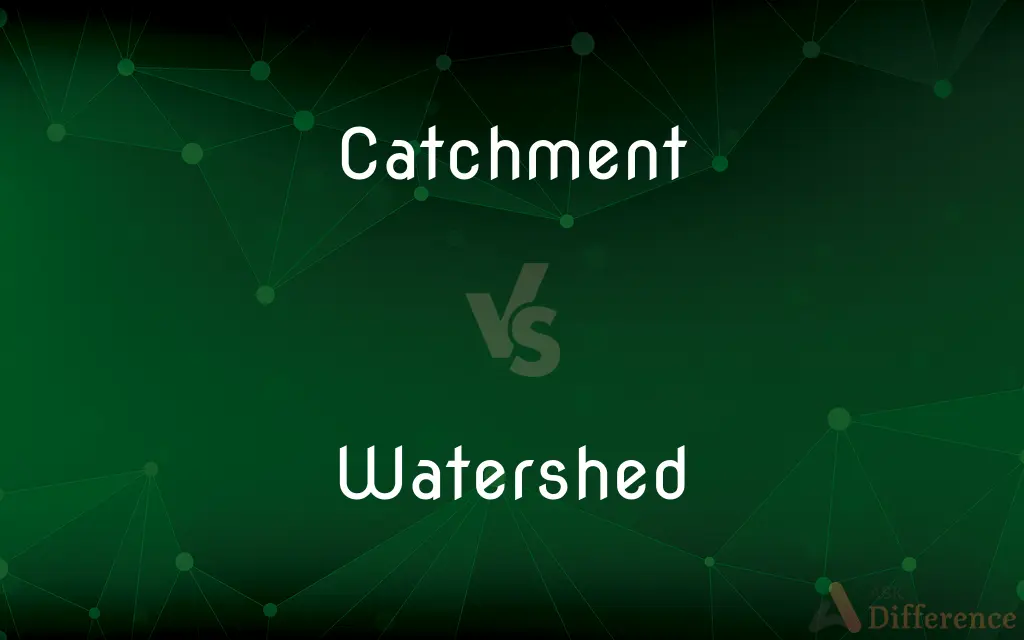Catchment vs. Watershed — What's the Difference?
By Tayyaba Rehman & Urooj Arif — Updated on March 10, 2024
A catchment is an area from which water is collected by the natural landscape, while a watershed represents the dividing line from which water flows into different catchments.

Difference Between Catchment and Watershed
Table of Contents
ADVERTISEMENT
Key Differences
catchment refers to an area of land where water from rain, snow, or ice melt collects and drains off into a common outlet, such as a river, bay, or other body of water. It is defined by the natural contours of the landscape, with all water within the area funneling into the same drainage system. Watersheds, on the other hand, are the geographic boundaries that separate one catchment area from another. They are defined by high points in the landscape, such as mountain ridges or hills, where water will flow down one side into one catchment and down the opposite side into another.
Catchments can vary significantly in size, ranging from a few square kilometers for small creeks or streams to thousands of square kilometers for major river basins. They play a crucial role in the hydrological cycle, affecting water quality, supply, and ecosystem health within their boundaries. Watersheds serve as critical dividing lines in the landscape, determining the direction in which water flows and ultimately influencing the catchment areas it supports.
The terms catchment and watershed are often used interchangeably, especially in regions like the United States, where "watershed" is commonly used to describe an area that drains into a particular water body. However, in a strict sense, the watershed refers to the boundary that separates these areas, not the area itself.
Management practices within catchments are essential for water resource sustainability, including water quality protection, flood management, and ecosystem conservation. Watershed management involves understanding and respecting these natural boundaries to ensure that activities in one area do not adversely affect neighboring catchments.
Despite their differences, both catchments and watersheds are integral to understanding and managing water resources. They highlight the interconnectedness of land, water, and ecosystems, emphasizing the importance of holistic environmental stewardship.
ADVERTISEMENT
Comparison Chart
Definition
An area where water is collected by the natural landscape and drains into a common outlet.
The geographic boundary that separates one catchment area from another.
Focus
The collection and drainage of water within a specific area.
The high points in the landscape that determine the flow direction of water.
Size
Can vary from small to large, depending on the drainage system.
Defined by the high points around catchment areas, not by size.
Role in Hydrology
Integral to the hydrological cycle, affecting water supply and ecosystem health.
Determines the direction of water flow and influences catchment areas.
Management Practices
Focuses on water quality, supply, and ecosystem conservation within the catchment.
Involves respecting natural boundaries to prevent adverse effects on adjacent catchments.
Compare with Definitions
Catchment
A catchment encompasses the land area draining into a river, lake, or other water bodies.
The Mississippi River catchment covers a vast area across multiple U.S. states.
Watershed
A watershed acts as a boundary separating one catchment from another.
The Rocky Mountains form a watershed dividing the Pacific and Atlantic catchment areas in North America.
Catchment
It serves as a natural basin for collecting precipitation and runoff.
The catchment area collects rainwater, contributing to the river's flow.
Watershed
Defined by the highest points in an area, like mountain ridges.
The watershed between two river basins is marked by a ridge that directs rainfall into one basin or the other.
Catchment
Catchments are crucial for maintaining local ecosystems and biodiversity.
The health of the wetlands within the catchment directly affects local wildlife.
Watershed
Watershed management involves coordination between different catchment areas.
Agreements between states or countries sharing a watershed are essential for equitable water resource management.
Catchment
Catchment management includes water quality monitoring and land use planning.
Urban development in the catchment area requires careful planning to avoid water pollution.
Watershed
Watershed conservation helps protect water quality and ecosystems in adjacent catchments.
Maintaining forest cover along the watershed helps reduce runoff and erosion.
Catchment
Plays a key role in the regional hydrological cycle by gathering and distributing water.
Changes in the catchment's land use can alter the hydrological balance, affecting water availability.
Watershed
Determines which catchment area precipitation will flow into.
Snowmelt on one side of the watershed feeds into the Colorado River, while the other side drains into the Columbia River.
Catchment
A catching or collecting of water, especially rainwater.
Watershed
The entire region draining into a river, river system, or other body of water
A list of reptiles found in the watershed. Also called basin, drainage basin.
Catchment
A structure, such as a basin or reservoir, used for collecting or draining water.
Watershed
A ridge of high land dividing two areas that are drained by different river systems. Also called divide, water parting.
Catchment
The amount of water collected in such a structure.
Watershed
A critical point that marks a division or a change of course; a turning point
"a watershed in modern American history, a time that ... forever changed American social attitudes" (Robert Reinhold).
Catchment
A catchment area.
Watershed
The topographical boundary dividing two adjacent catchment basins, such as a ridge or a crest.
Catchment
Any structure or land feature which catches and holds water; the collection of such water.
Watershed
A region of land within which water flows down into a specified body, such as a river, lake, sea, or ocean; a drainage basin.
Catchment
A catchment area, or the people it serves.
Watershed
(figurative) A critical point marking a change in course or development.
Catchment
To divide into catchment areas.
The catchmenting of mental health services
Watershed
Serving to mark a significant development, change in direction, etc.
Catchment
A surface of ground on which water may be caught and collected into a reservoir.
Watershed
The whole region or extent of country which contributes to the supply of a river or lake.
Catchment
A structure in which water is collected
Watershed
The line of division between two adjacent rivers or lakes with respect to the flow of water by natural channels into them; the natural boundary of a basin; - called also divide and water parting.
Watershed
A point in time marking an important transition between two situations, or phases of an activity; a turning point.
Watershed
A ridge of land that separates two adjacent river systems
Watershed
An event marking a unique or important historical change of course or one on which important developments depend;
The agreement was a watershed in the history of both nations
Common Curiosities
How do human activities impact catchments and watersheds?
Human activities, such as urban development, agriculture, and deforestation, can significantly impact catchments and watersheds by altering water flow, reducing water quality, and affecting ecosystem health.
What is a catchment area in environmental science?
In environmental science, a catchment area is the land that collects precipitation and contributes to the flow of water into a common outlet like a river, lake, or reservoir.
How is a watershed defined geographically?
Geographically, a watershed is defined by the highest points in an area, such as mountain ridges or hills, that determine the direction in which water will flow.
How can watershed management contribute to flood prevention?
Watershed management can contribute to flood prevention by maintaining natural vegetation, restoring wetlands, and implementing land use practices that enhance water infiltration and reduce surface runoff.
Can catchment areas overlap?
Catchment areas do not overlap; each catchment is defined by its own unique boundaries, with watersheds serving as the dividing lines between them.
What role do catchments play in water supply?
Catchments play a crucial role in water supply by collecting precipitation and channeling it into rivers, lakes, and underground aquifers, which are critical sources for drinking water, irrigation, and industrial use.
How does land use within a catchment affect water quality?
Land use within a catchment, such as agriculture, urban development, and industrial activities, can affect water quality through runoff that carries pollutants like fertilizers, chemicals, and sediment into water bodies.
Why is watershed management important?
Watershed management is important for ensuring sustainable water use, protecting water quality, and preserving ecosystems in catchment areas, especially where multiple catchments share common resources.
What is the difference between a watershed and a drainage basin?
While a watershed refers to the dividing line between catchment areas, a drainage basin is synonymous with a catchment area, encompassing the land where water converges to a single point or outlet.
What is integrated catchment management (ICM)?
Integrated catchment management (ICM) is an approach that coordinates the management of land, water, and related resources within a catchment to achieve sustainable environmental, economic, and social outcomes.
How do wetlands within a catchment contribute to water quality?
Wetlands within a catchment act as natural filters, trapping pollutants, and sediments, which helps improve water quality before it flows into rivers, lakes, or aquifers.
Why is public awareness and participation important in catchment and watershed management?
Public awareness and participation are crucial because effective management of catchments and watersheds often requires collective action and cooperation among stakeholders, including local communities, to implement conservation practices and sustainable land and water use policies.
How are catchments and watersheds mapped and monitored?
Catchments and watersheds are mapped and monitored using geographic information systems (GIS), satellite imagery, and hydrological models to analyze topography, land use, water flow, and environmental changes.
What is the impact of climate change on catchments and watersheds?
Climate change impacts catchments and watersheds by altering precipitation patterns, increasing the frequency and intensity of extreme weather events, and affecting the distribution and availability of water resources.
What measures can be taken to protect watersheds?
Measures to protect watersheds include preserving natural vegetation, implementing sustainable land use practices, reducing pollution sources, and managing water extraction and use responsibly.
Share Your Discovery

Previous Comparison
Individualism vs. Collectivism
Next Comparison
Ignorant vs. ArrogantAuthor Spotlight
Written by
Tayyaba RehmanTayyaba Rehman is a distinguished writer, currently serving as a primary contributor to askdifference.com. As a researcher in semantics and etymology, Tayyaba's passion for the complexity of languages and their distinctions has found a perfect home on the platform. Tayyaba delves into the intricacies of language, distinguishing between commonly confused words and phrases, thereby providing clarity for readers worldwide.
Co-written by
Urooj ArifUrooj is a skilled content writer at Ask Difference, known for her exceptional ability to simplify complex topics into engaging and informative content. With a passion for research and a flair for clear, concise writing, she consistently delivers articles that resonate with our diverse audience.














































